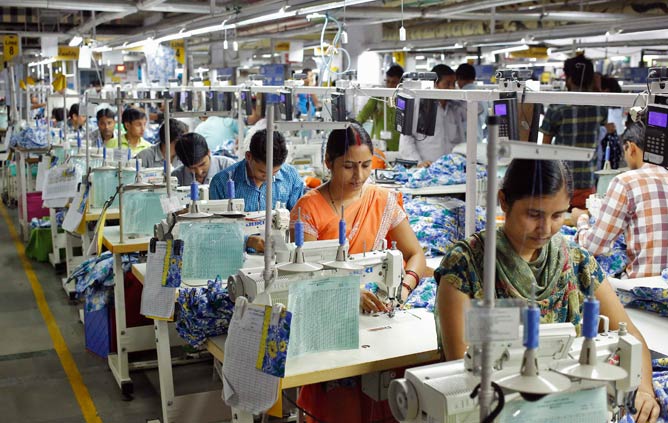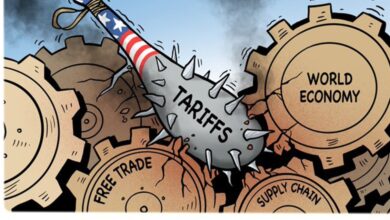
Thousands of apparel enterprises and manufacturers are forging the closure of their industries due to delayed orders. The manufacturers are in a dire state as several states opt for the makeshift shutdown of non-essential services. The highly procured retail markets of clothing and apparel manufacturing are substantially dependent on the movement of stocks from large retailers.
The disruption in transportation strategies could hurt the heavyweight and small-scale retailers in meeting the long-awaited demand of the customers. Brokerage Motilal Oswal, the famed figure in tracking the business of malls, apparel retailers, portrays a hallowed synopsis for the manufacturing sector in his report. He asserted that the surge in Covid-19 cases especially is grueling the efforts of the retailers reliant on the efficient movement of stocks.
The big-game textile industries have been operating at 70-80% of their conglomerate capacity than the pre-pandemic levels. The report refurbished that disruption in labor markets affected the overall manufacturing of many renowned industries like the Arvind Ltd., Vardhman Textile Ltd., and so on. It is becoming tirelessly imprudent for the companies to keep sustaining these elongated fresh lockdowns. Although the lockdown is not as harsh as the previous ones, the situation of the non-essential services has had large-scale ramifications. Retailers had bolstered their sales at 82% pre-covid levels over January-Feb 21.
However, the industries have coerced to put their foot down the parrel, which can further hinder the weakened whereabouts of retailers and manufacturers in the dynamic markets. Over the years, the apparel industry has seen an appealing rise due to more fashion trends and quirky stuff coming our way. The Brokerage claimed that apart from the most affected industries of tourism and hospitality, the apparel consumption from the in-house manufacturers would be significantly low.
The presumptions and the analysis have been made after consulting and talking to vital players and industry associations such as the Clothing Manufacturing Association of India.
The Small-Scale Apparel Manufacturers Were the Worst Hit Across the Textile Industry
The Clothing Manufacturing Association of India has perpetuated that the small retailers have been the worst hit during the pandemic overhaul. It asserted that the consumption levels had drastically tinkered with the perpetual shift of trends towards e-commerce websites. It affected the large proportion of smaller players, and they validated the thought of closing down their businesses. The situation has made them vulnerable to the uncertain outlook of the economy. IndustriALL, the global trade union, protects the rights and the freedom of expression of various workers.
Globally, millions of garment makers and apparel retailers have either been furloughed from their jobs or vented the downfall of their enterprise. Either way, the textile industry excruciated the crippling crisis of the virus. Stretched working and liquidity capital issues play a crucial role in conducting trade businesses in India with other conglomerates, delineated to be the main factor of the subsequent ruination. According to the industrial survey conducted by Motilal Oswal, approximately 80% of the apparel manufacturing sector stands highly unorganized and contingent on the adequate transfer flow of cash and credit resources. It reverberated that the state’s decision to waver the lockdown would have fretful implications on the industry, remarkably the small-scale contingencies of the markets.
The untethering demand for the products and the lower consumer penetration have captivated the manufacturers. The ever-growing inventory of these houses piled up to extravagant levels during the lockdown, and without certainty over the gauging of domestic products in the export markets as well, they were forced to shut down. The retailers in Maharashtra and Delhi were sluggish to get out of the packs to commence their operations after the government reopened the activities, fearing the economy’s crumbling after facing the consequences of the initial phase of the pandemic. The demand has been staggering, and as they faced the restraints of no fresh stock, they suffered hindrances in progress in the aftermath of the lockdown.

The Trends of the E-Retail Markets Surfaced A Turmoil to the Industry.
In the global fashion industry, the retailers are over-reliant on the efficient flow of adequate cash for congruently administering their business activities. An interpretative study on the effects of E-shopping had on small-scale and medium enterprises got published by AP Shemi. In his analysis, he reiterated the compelling fact that over 86% of the Indians preferred online shopping of clothes and accessories over the traditional methods. Various survey reports from renowned experts surfaced around, which said that the lack of demand and antiquated trends have led to the regression of the retailing industry in India.
The stocks available on the online website are more fashionable and unraveling, which has made the competition fierce and the lives of the retailers burdensome. The e-retail markets have stepped up their game as the survey report published by IT company Capgemini. It further stated that around 46 percent of Indian customers stopped fascinating the idea of going to physical stores and buying their merchandise. It piled up the inventory stocks, and the maintenance costs of the small-scale retailers also spiked. Most consumers felt content with the practices adopted by the giants of the e-commerce industry.
What hampered the process of the small-scale retailers was the need to raise the cost of the products due to the high stakes of surviving the pandemic toll. It divulged the thought process of the online websites as it offered more eye-gazing discounts and coupons imminently. The e-retail markets do offer the privilege in a variety of payments which has provided the customers with a convenient trend of buying today, pay later.
Moreover, contrary to the scheme, the high credit period is a significant concern for the apparel manufacturers. Although there had been fewer entry barriers in the apparel industry compared to the e-retail industries, high credit has historically been a constant constraint in the growth progress of the manufacturers and the vendors. The vendors have been troubled with the lack of movement on roads, and their migration to their native places hasn’t served them well.

The Credit Factor Has Limited the Scope for the Small Apparel Industry.
The report surfaced a detailed prognosis about the prevailing situation of the apparel industry both domestically and internationally. But moving ahead, we will focus on the high credit burden that has been ineffective and led to the downfall of domestic apparel appeal since the pandemic. Eventually, the credit factor in the domestic markets hasn’t faded with the implementation of the new reforms. It has sustained itself over the decade and has strengthened its position pre-dominantly since the emergence of the pandemic.
The Covid-19 pandemic has changed our habits in a way that we longer sought deals in cash. It is primarily because of the fear of job security that has hindered the progress of around 400 million people in the Indian economy. There have been massive letdowns in the industry that are significantly dependent on complying with the demand-supply factor. The government and the judicial system have only helped in an involuntarily way stating the people not to shut down their businesses.
Is it enough merely to provide moral support and not lend or amend policies to address the stumbling blocks in raising the income of the corporate houses and small-scale industries, especially the people who are reliant on cash inflow for their belongings. The lack of satisfactory income has shifted the thought process of the customers. They have become more reliant or dependent on procuring more savings as you never know that such a global crisis might occur in the foreseeable future.
While the propellant nature of the economy favored against the protruding economy as people did not wish to work on credit, the apparel industry failed to capture the market since the reopening of the lockdown. The mobilization of low capital and the optimization of costly resources have left thousands of people running businesses at a weakened stance.
The Staggered Position is A small Indication of the Global Scenario.

The analysis and the trends that we exhibited since the lockdown are not the ideal scenarios of the apparel industry in India, but the textile industry has suffered huge losses globally. Understanding the kind of repercussions that happened in the behavioral patterns of the customers, Shopify released its report on the Future of Commerce. Apparel manufacturing and retail shops are the relationships that get built between the seller and the consumers.
The highest shift in the consumer base has been driven by the younger and middle-aged. While they got attracted towards more vibrant and organic shades and trends, highly driven by seasonal sale discounts, the global textile manufacturers found it difficult to adapt to the conditional changes. The ILO Siraye Programme conducted a regional survey on studying the impact of Covid-19 on the factory operational activity.
It reported that 54% of the factories surveyed expected a substantial decrease in the revenues. It was highly deepened due to the lack of uncertainty of supply gauging across international markets for garments and apparel. The liquidity in transactions has wavered, and the setbacks of not evolving with the trends have settled.
A large proportion of the growth prospects have got stamped down due to the lack of financial security, which the cabinet and the state government promised during the initial few months of the lockdown. When we think of focusing on the notion of Self-Reliant India, it is impromptu to provide these small-scale industries a chance to expand their resources. The textile industry in India is one of the most prolific ones prevailing as the trends never fade away.
It is the second-largest employment generation industry in India. The share of exports can’t be raised if the striving needs of the small manufacturers in the industry do not get fulfilled. Around 45 million to 60 million people get employed in the textile industry, so you might wonder how long the tables have turned that the situation of the businesses and the industries have gone so grim. The second wave is not ameliorating the roadblock in the journey of the apparel manufacturers, and the position of the domestic markets even further could deteriorate as the states mules on extending the lockdown.




